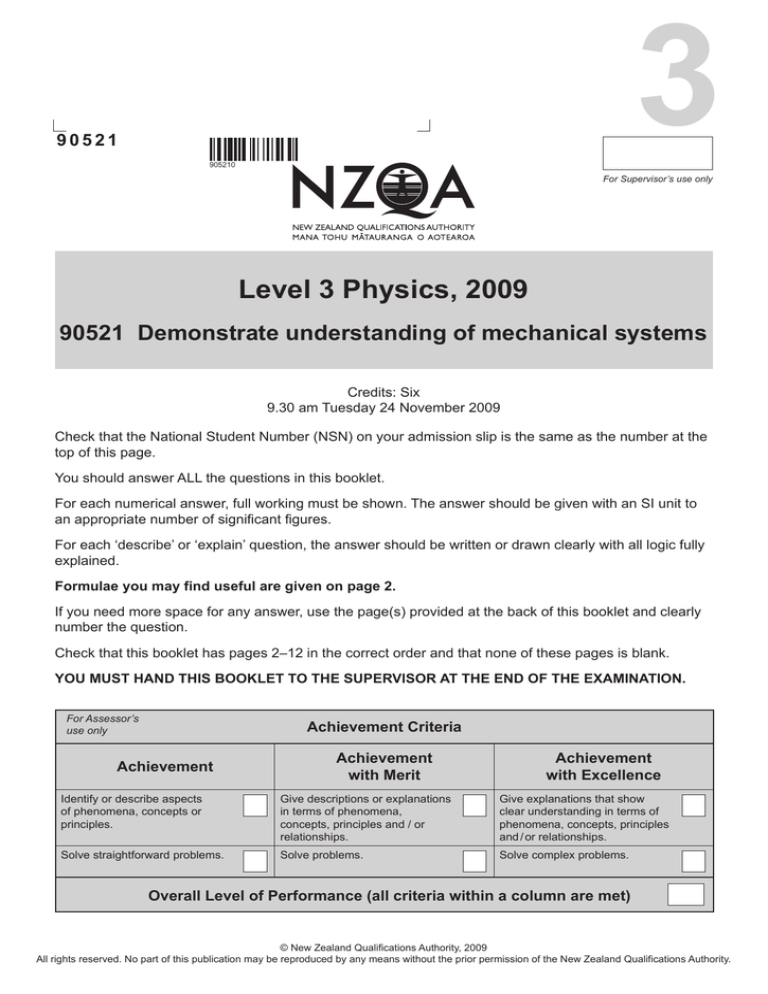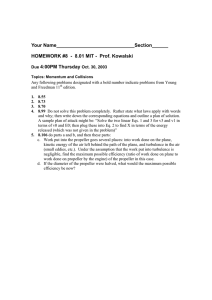
3
90521
905210
For Supervisor’s use only
Level 3 Physics, 2009
90521 Demonstrate understanding of mechanical systems
Credits: Six
9.30 am Tuesday 24 November 2009
Check that the National Student Number (NSN) on your admission slip is the same as the number at the
top of this page.
You should answer ALL the questions in this booklet.
For each numerical answer, full working must be shown. The answer should be given with an SI unit to
an appropriate number of significant figures.
For each ‘describe’ or ‘explain’ question, the answer should be written or drawn clearly with all logic fully
explained.
Formulae you may find useful are given on page 2.
If you need more space for any answer, use the page(s) provided at the back of this booklet and clearly
number the question.
Check that this booklet has pages 2–12 in the correct order and that none of these pages is blank.
YOU MUST HAND THIS BOOKLET TO THE SUPERVISOR AT THE END OF THE EXAMINATION. For Assessor’s
use only
Achievement Criteria
Achievement
Achievement
with Merit
Achievement
with Excellence
Identify or describe aspects
of phenomena, concepts or
principles.
Give descriptions or explanations
in terms of phenomena,
concepts, principles and / or
relationships.
Give explanations that show
clear understanding in terms of
phenomena, concepts, principles
and / or relationships.
Solve straightforward problems.
Solve problems.
Solve complex problems.
Overall Level of Performance (all criteria within a column are met)
© New Zealand Qualifications Authority, 2009
All rights reserved. No part of this publication may be reproduced by any means without the prior permission of the New Zealand Qualifications Authority.
2
You are advised to spend 55 minutes answering the questions in this booklet.
You may find the following formulae useful.
Δp = FΔt
ΔEP = mgΔh
v = rω
a = rα
ω=
ω = 2πf
f =
Fnet = ma
p = mv
W = Fd
EK(LIN) = 2 mv 2
d = rθ
α=
Δω
Δt
1
(ω i + ω f )
t
2
ω f = ω i + αt
θ=
τ = Iα
τ = Fr
Fg =
GMm
r2
Fc =
1
T
Δθ
Δt
1
EK(ROT) = 2 Iω 2
1
ω f 2 = ω i 2 + 2αθ
θ = ω it + 2 α t 2
L = mvr
L = Iω
mv 2
r
1
l
g
F = −ky
EP = 2 ky 2
T = 2π
y = Asin ω t
v = Aω cos ω t
a = −Aω 2 sin ω t
y = A cos ω t
v = −Aω sin ω t
a = −Aω 2 cos ω t
Physics 90521, 2009
T = 2π
m
k
a = −ω 2 y
3
This page has been deliberately left blank.
Physics 90521, 2009
4
QUESTION ONE
Assessor’s
use only
Acceleration due to gravity = 9.81 m s–2
Sam enjoys flying vintage aeroplanes. One of the planes Sam flies has a mass, when operating, of
635 kg.
For copyright reasons,
this resource cannot be
reproduced here.
http://en.wikipedia.org/wiki/File:Sopwith_F-1_Camel_2_USAF.jpg
In order to turn the plane in a horizontal circle at constant speed, Sam tilts, or banks, the plane at an
angle of 22.5°. The free-body forces on the plane are shown in the diagram below.
lift force
22.5°
force due to gravity
(a)
Show that the size of the vertical component of the lift force is 6230 N.
Physics 90521, 2009
5
(b) Calculate the size and direction of the resultant force on the plane during this turn.
size =
direction =
In another constant speed horizontal turn, the plane has a centripetal acceleration of 2.50 m s–2.
(c)
Calculate the angle of banking of the plane in this turn.
angle =
(d) For a plane to turn in a horizontal circle at a steady speed, it is necessary to tilt the plane.
By considering all the forces that act on the plane, explain why this is the case.
Physics 90521, 2009
Assessor’s
use only
6
QUESTION TWO
Assessor’s
use only
To start the plane, Sam has to turn the propeller by hand. When the propeller reaches a high enough
angular velocity, the engine will be able to start. The propeller has a rotational inertia of 16.5 kg m2.
The engine will start when the propeller is turning at 100 revolutions per minute (rpm).
(a)
Show that 100 rpm is 10.5 rad s–1.
Sam is able to apply a constant torque to the propeller for ⅓ of a revolution.
1
⁄3 ro
ta
n
tio
(b) The propeller is at rest when Sam starts to turn it. Calculate the minimum constant torque he
must apply to start the engine.
torque =
(c)
Sam wants to fit a new propeller, of the same length, which will be easier to accelerate to
100 rpm.
Explain how the new propeller might be different to the existing propeller.
Physics 90521, 2009
7
(d) When the engine is shut off, the propeller takes 20.0 s to come to a complete stop from an
angular velocity of 37.7 rad s–1.
Calculate the number of turns the propeller completes while it slows to a stop. State any
assumption(s) you have made.
number of turns =
Assumption(s):
Physics 90521, 2009
Assessor’s
use only
8
QUESTION THREE
Assessor’s
use only
Acceleration due to gravity = 9.81 m s–2
The suspension in Sam’s plane contains large springs that make landing on rough airstrips more
comfortable.
The uncompressed length of the springs is 55.0 cm. When they are placed on the plane (of mass
635 kg), they are compressed to a length of 37.5 cm.
(a)
Show that the force constant (k) of the springs is 3.56 × 104 N m–1.
(b) When the plane goes over a bump, it starts oscillating with vertical simple harmonic motion.
Show that the period of the simple harmonic motion is 0.839 s.
The phasor diagram below shows the displacement phasor at one instant, when the amplitude of the
simple harmonic motion is 15 cm.
y
15 cm
60°
(c)
By drawing the velocity phasor on the diagram or by another method, describe the vertical
velocity of the plane at this instant.
Physics 90521, 2009
9
(d) Calculate the vertical acceleration of the plane at the instant shown in the phasor diagram.
acceleration =
(e)
Shock absorbers help improve the comfort for passengers by damping the simple harmonic
motion.
Describe the effect of moderate damping on the displacement and acceleration of the
oscillating plane, and discuss how damping will affect the discomfort felt by a passenger. You
may use the grid provided to help illustrate your answer.
Physics 90521, 2009
Assessor’s
use only
10
QUESTION FOUR
Assessor’s
use only
After flying, Sam relaxes with a game of pool.
The diagrams below show what appeared to occur during one shot. Ball 1 has a mass of 0.146 kg
and ball 2 has a mass of 0.165 kg.
Diagram is
NOT to scale
BEFORE
1
v = 9.00 m s–1
p = 1.31 kg m s–1
2
AFTER
v = 4.00 m s–1
1
2
θ
(a)
Calculate the velocity of the centre of mass of the system before the balls collide. You can
assume that the diameter of the balls is small so that ball 1 is travelling directly towards ball 2.
velocity =
(b) State what happens to the velocity of the centre of mass of the system during the collision.
Give a reason for your answer.
Physics 90521, 2009
11
(c)
Calculate the size of the change in velocity of ball 1.
Assessor’s
use only
change in velocity =
(d) Calculate the final velocity (magnitude and direction, θ ) of ball 2.
velocity =
θ=
1 2
mv , Sam finds that the total linear kinetic energy of the two balls increases
2
during the collision.
(e)
By using EK =
By considering all possible forms of energy involved, provide a reason why this collision is
theoretically possible.
Physics 90521, 2009
12
Extra paper for continuation of answers if required.
Clearly number the question.
90521
Question
number
Physics 90521, 2009
Assessor’s
use only


